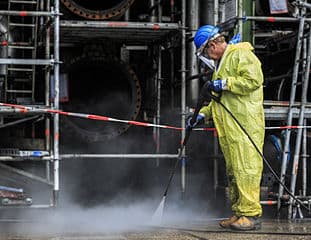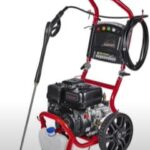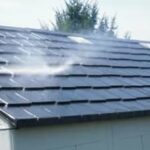As an Amazon Associate, this site earns commissions from qualifying purchases. For more information click here.
The pump is one of the most important parts of a pressure washer, so you have to make certain it is operating properly. If the pump is leaking or the pressure goes down, you know right away there is something wrong. By reading this article you will learn the most common signs of a damaged pump and what the reasons are.
Lack of pressure or a water leak are the most common signs of a bad pressure washer pump. No pressure is due to a damaged inlet valve while damaged gaskets can cause water or oil leaks.
Pump is Leaking Water
A broken seal is the most common reason for a pressure washer pump leak. The gasket and related parts are worn out over time. When this happens, water is going to leak through the pump.
Solution. The first step is to find out where the leak is coming from. Take off the pressure washer case. Turn on the water and keep the engine off. As the water goes through the hose you will see where the leak is at.
Replace the gasket, O ring or seal. If those parts are still new, check the cylinder for leaks. Make sure to drain the water before the cold season begins. Using the technique above, you should be able to identify the source of the leaks.
A lot of factors determine how long a pressure washer lasts. One of the best ways to extend its lifespan is proper maintenance. By checking out and fixing leaks, problems can be avoided.
Faulty Unloader Valve
A lot of pressure washer issues stem from the unloader valve. This is the part that manages the pressure, so if the motor stalls or the washer is not running correctly, it probably means there is something wrong with the unloader valve.
Solution. If the valve is damaged it must be replaced. If the valve is fine, adjust its settings as indicated in your owner’s manual. The Karcher K 5 Premium 2000 PSI makes this task particularly easy.
If changing settings does not work, look for damages to the seals, gaskets or pistons. Replace the worn out parts and try the washer again.
The piston in particular plays an important role while you run the pressure washer. If there is a problem with the piston and it stops moving, the pressure washer will stall. If this happens, shut the machine down, take out the piston and look for signs of damage. Replace it if necessary.
You have to fix any damage to the unloader valve as soon as possible. If you don’t this can damage the pump and other components.
One possible scenario is when the unloader valve prevents water from getting into the inlet, which will cause massive pressure on the pump. This in turn affects the piston as it takes more time to create the water diversion flow. One way to prevent this is by re-configuring the unloader valve settings, assuming it is not damaged.
Little to No Pressure
The problem is a malfunctioning pump or a damaged O ring. It could also be due a worn out gasket. Any of these can affect the pump and reduce the pressure.
Solution. The O-ring is usually the cause so that is the first place you should look. Replace the O-ring. If you did and there is still no pressure, the filters might be clogged. Check the filters and clean thoroughly. Restart the pressure washer and it should run fine now.
Filters naturally get dirty over time, so it is a good idea to clean them regularly. If the filters get too dirty way too often, it is time to replace them. Do this and water should get to the pump and nozzle easily.
Pulsing
If the pressure is puling or pulsating, it is due to lack of inlet water. With gas pressure washers you will notice inconsistent pressure every time you use it. If your pressure washer is electric like the Sun Joe SPX4000-PRO, the motor will restart frequently. This can happen anytime but the solution is straightforward.
Solution. Turn off the pressure washer and clean the inlet filter. Replace the filter if necessary. Reinstall the cleaned (or new) filter and try the pressure washer again. If it is still leaking, turn the machine off. Inspect the cylinder for leaks and the pump too. Replace them if there are leaks.
Pressure Keeps Changing
Have you noticed the water pressure keeps changing? Maybe the pressure is normal when you start then it gets low. Or maybe it is low to begin with then goes up and then low again. This is caused by a damaged inlet valve.
Solution. The only fix in this case is to replace the inlet valve. Fixing it is going to take a lot of work and something only a professional can do. And even if you get to repair it, the inlet valve will not be the same as before, so might as well get a new one.
The Pump is Drawing Air
This is caused by pressure trapped in the pump. How you fix this depends on the source of the problem.
Solution. If this is due to air in the pump, the fix is easy. Shut the washer off and squeeze the trigger. This forces the air out of the pump. Turn the washer on again and it should run normally.
If that does not work or there are other problems, it could be the pump itself. Try cleaning the pump to see if that helps. If that does not work, the pump is probably defective and needs to be replaced.

Pump is Leaking Oil
Seeing oil leak from a pressure washer pump can be alarming. There are many possible reasons why this happens so you have to go through them one by one.
Solution. The first thing you have to do is take the pump apart to access the pistons, gaskets and seals. Clean these parts if dirty then try the washer again. If it still leaks oil, the seal, gasket or piston may be damaged and need to be replaced.
Loose pump bolts can also cause oil leaks. Examine the bolts and fittings on the pump. Tighten the bolts if necessary then try the pressure washer again.
Related: how to fix oil leaks in a pressure washer
Noisy
Everything was going fine then suddenly your pressure washer starts making a lot of noise. The pump and motor are not damaged and water pressure is fine. So what could be causing it?
Solution. The noise is being caused by lack of oil. Shut off the pressure washer and inspect the tank. If there is not enough oil, empty the tank and refill it. If the oil is old, gummy or cloudy, replace with fresh oil. Depending on your pressure washer design this might require you to disassemble the pump.
How to Use a Pressure Washer Pump Protector
As its name suggests, a pressure washer pump protector is used to safeguard the pump. If you are going to store a pressure washer for the winter (or any long period), water and oil can precipitate mineral buildup. The engine might rust or gummy oil could spread all over the pistons and seals.
A pump protector lubricates the engine and related parts so oil and minerals do not stick to it. A pump protector will also prevent water from turning into ice during winter, as this could damage the pump.
To apply a pump protector, shut off the pressure washer, including the engine. Disconnect every hose. Get the pump protector and remove the screw on top. Take the seal off before closing the bottle.
Take off the cap at the top so its garden hose thread is visible. Go to the pump inlet and fasten the bottle into the fitting for the hose.
Squeeze the bottle until the fluid flows. If you have an electric pressure washer, turn it on and leave it open until the fluid is discharged. For a gas pressure washer, keep pulling the starting cord until the fluid is discharged. When finished, disconnect the bottle.

I love the outdoors and all the tools for maintaining gardens, yards and lawns. The only thing I am more passionate about is sharing what I know about garden and outdoor equipment.


